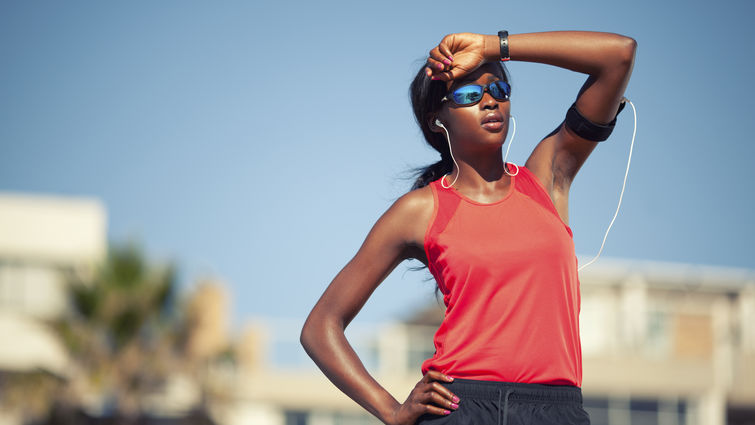

As the summer months usher in the blistering heat, exercising can be challenging due to hot and sometimes humid weather conditions. Doctors say the warmer weather calls for careful planning to ensure summer workouts are both effective and safe.
"Exercising in the heat increases the risk of dehydration, heat exhaustion, and heatstroke,” says Jason Hoff, MD, a cardiologist at Loma Linda University International Heart Institute. “It's essential to take precautions, stay hydrated, and listen to your body's signals to ensure a safe and effective workout."
By understanding the risks and adopting a few simple yet mindful strategies, you can stay active and healthy while enjoying the sun-drenched days. Here’s how to maximize summer workouts without compromising your well-being.
Exercising during cooler parts of the day
The intensity of the sun is strongest between 10 a.m. and 4 p.m. To avoid peak heat, schedule your workout early or later in the day. “Anything before 8 a.m. and after 7 p.m. tends to be a lot cooler and can help prevent heat-related illnesses, and it makes your workouts more enjoyable and less strenuous,” Hoff says. He also recommends avoiding outdoor exercise when the temperature exceeds 90 degrees.
Stay hydrated
Staying hydrated during a workout is critical, but it all starts with prehydration. Hoff suggests prehydrating with two large cups of water up to two hours before a workout. This will allow your body to get to a more neutral hydration status for a workout.
While plain water is better before a workout, Hoff suggests incorporating carbohydrates, sodium, and electrolytes into water during exercise. Depending on the intensity of the workout, Hoff says a good rule of thumb is to drink 5 to 10 ounces of fluid every 15 minutes to maintain hydration.
Dress appropriately
Wearing the proper clothing can significantly improve exercise on a hot day. Hoff recommends wearing light-colored, loose-fitting, sweat-wicking fabrics — commonly known as athletic wear. Proper athletic clothing allows the skin to sweat and stay cool, while materials like cotton shirts trap heat by absorbing moisture and weighing you down. When exercising outdoors, wearing a hat shields your head and face from the hot summer sun.
Sunscreen
Outdoor workouts often lead to prolonged sun exposure, which increases the likelihood of skin damage. “Wearing sunscreen is not about staying cool; rather, it’s crucial for avoiding a bad sunburn, which increases your risk of skin cancer,” Hoff says. “When choosing sunscreen, aim for an SPF of 50 or higher and look for a waterproof formula so it doesn't wash off when you start sweating.”
Indoor workouts
If you have access to a local gym or indoor workout area, it’s a good alternative to exercising outside. This is especially true when the temperature exceeds 90 degrees, the air quality is poor, or the weather is humid. Humidity increases stress on the body because sweat cannot evaporate effectively, while dry heat allows sweat to evaporate, helping to keep the body cooler.
Listen to your body
It's perfectly fine to back off when you're exercising in the heat, Hoff says. If you have pre-existing heart disease or other chronic conditions such as diabetes, it can put more strain on your heart, especially when you're dehydrated.
"Heat stroke, which can be a fatal condition, and other heat-related illnesses such as muscle cramps and heat exhaustion, can lead to a medical emergency,” Hoff warns. “Even if you're drinking a lot of water, if you're not careful with replenishing the sodium you're losing when exercising in the heat, it can be dangerous, which is why it’s imperative to listen to your body.”
If you begin to feel excessive tiredness, weakness, nausea, dizziness, clammy skin, or a flushed and pale face during your workout, these could indicate signs of heat exhaustion. If you notice any of these symptoms, Hoff recommends finding a shady spot to sit and rehydrate your body.
Give yourself grace
The heat can be discouraging for those just starting their fitness journey or returning to exercise after a long break. To stay motivated and avoid giving up, Hoff suggests the following tips.
-
On days when the heat poses potential safety risks, consider limiting workouts to 15-30 minutes. Remember, even 15 minutes of exercise can lead to significant long-term benefits.
-
Instead of an intense workout, walk or exercise at a lower intensity.
-
If possible, participate in water activities like swimming, surfing, and paddleboarding. According to Hoff, swimming is the best summer workout, providing cardio benefits similar to running or biking.
Loma Linda University International Heart Institute care teams are committed to providing patients with compassionate, comprehensive, and personalized cardiovascular care. To learn more, please visit lluh.org/heart-vascular or call 1-800-468-5432.


